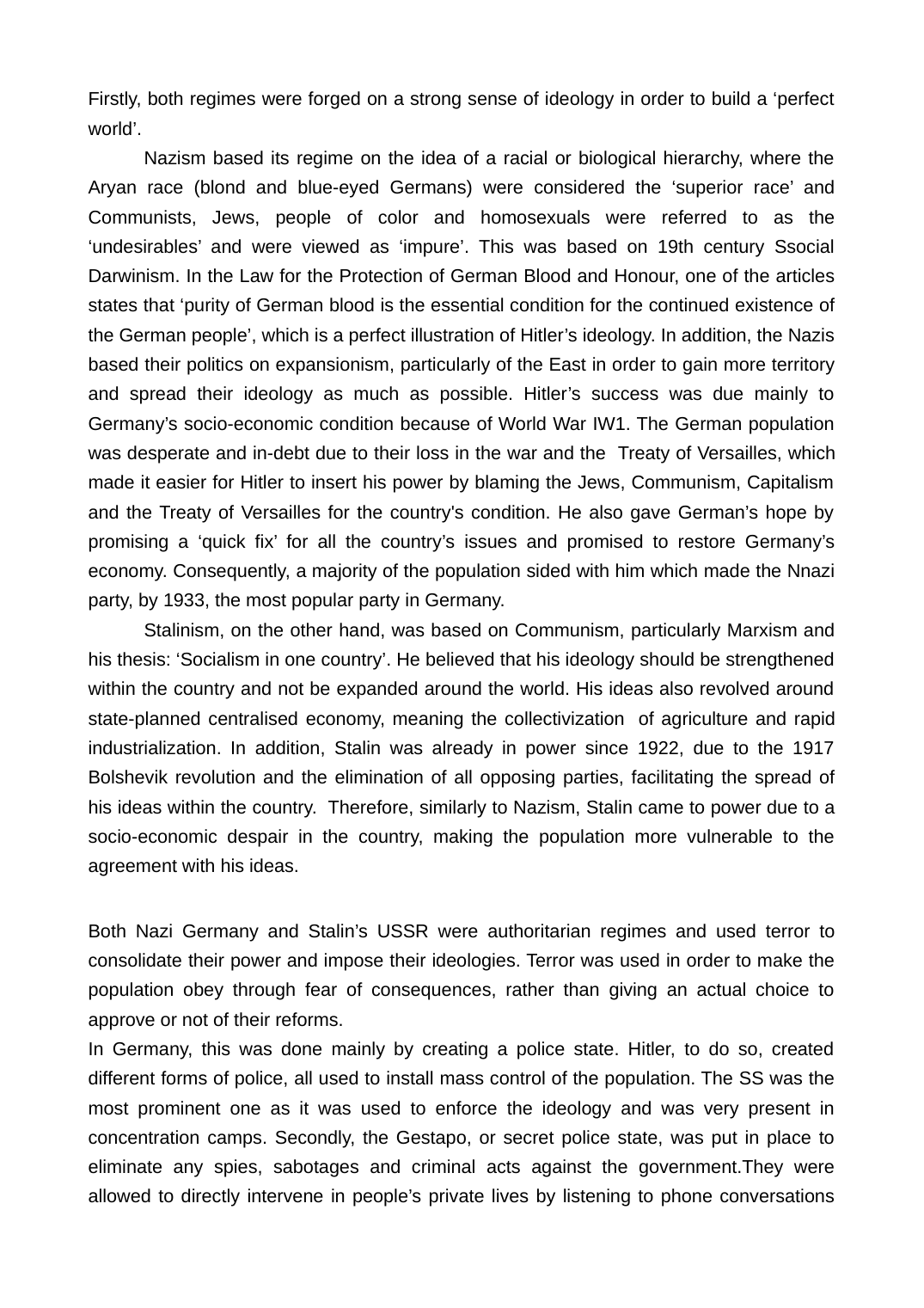Comparative Essay USSR and Nazi Germany
Publié le 15/01/2022
Extrait du document
«
Firstly, both regimes were forged on a strong sense of ideology in order to build a ‘perfect
world’.
Nazism based its regime on the idea of a racial or biological hierarchy, where the
Aryan race (blond and blue-eyed Germans) were considered the ‘superior race’ and
Communists, Jews, people of color and homosexuals were referred to as the
‘undesirables’ and were viewed as ‘impure’.
This was based on 19th century Ssocial
Darwinism.
In the Law for the Protection of German Blood and Honour, one of the articles
states that ‘purity of German blood is the essential condition for the continued existence of
the German people’, which is a perfect illustration of Hitler’s ideology.
In addition, the Nazis
based their politics on expansionism, particularly of the East in order to gain more territory
and spread their ideology as much as possible.
Hitler’s success was due mainly to
Germany’s socio-economic condition because of World War IW1.
The German population
was desperate and in-debt due to their loss in the war and the Treaty of Versailles, which
made it easier for Hitler to insert his power by blaming the Jews, Communism, Capitalism
and the Treaty of Versailles for the country's condition.
He also gave German’s hope by
promising a ‘quick fix’ for all the country’s issues and promised to restore Germany’s
economy.
Consequently, a majority of the population sided with him which made the Nnazi
party, by 1933, the most popular party in Germany.
Stalinism, on the other hand, was based on Communism, particularly Marxism and
his thesis: ‘Socialism in one country’.
He believed that his ideology should be strengthened
within the country and not be expanded around the world.
His ideas also revolved around
state-planned centralised economy, meaning the collectivization of agriculture and rapid
industrialization.
In addition, Stalin was already in power since 1922, due to the 1917
Bolshevik revolution and the elimination of all opposing parties, facilitating the spread of
his ideas within the country.
Therefore, similarly to Nazism, Stalin came to power due to a
socio-economic despair in the country, making the population more vulnerable to the
agreement with his ideas.
Both Nazi Germany and Stalin’s USSR were authoritarian regimes and used terror to
consolidate their power and impose their ideologies.
Terror was used in order to make the
population obey through fear of consequences, rather than giving an actual choice to
approve or not of their reforms.
In Germany, this was done mainly by creating a police state.
Hitler, to do so, created
different forms of police, all used to install mass control of the population.
The SS was the
most prominent one as it was used to enforce the ideology and was very present in
concentration camps.
Secondly, the Gestapo, or secret police state, was put in place to
eliminate any spies, sabotages and criminal acts against the government.They were
allowed to directly intervene in people’s private lives by listening to phone conversations.
»
↓↓↓ APERÇU DU DOCUMENT ↓↓↓
Liens utiles
- Citizens assemblies and global warming (short essay)
- Essay English : In Arthur Miller's play "All my sons", Joe Keller is a hero in his family and in the neighborhood even if he did some very awful things.
- Do you believe that pop culture has made women nudity and body an object ?
- The danger of space exploration on the human body and the environment
- ART AND POWER

































